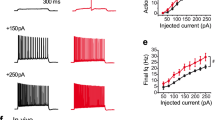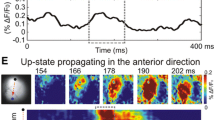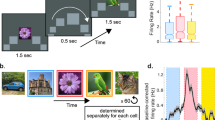Summary
Most hippocampal formation single units in freely behaving rats fall into one of two categories (Ranck 1973). The most obvious behavioral correlate of complex-spike (CS) cells is spatially selective discharge (O'Keefe and Dostrovsky 1971), while theta cells show increased firing in phase with the EEG θ rhythm associated with Vanderwolf's Type I behaviors (e.g. walking, exploration). Recently, Colom and Bland (1987) described, in urethane anesthetized animals, a class of non-CS cell which was inactive in the presence of EEG θ and discharged continuously during LIA. They called these “theta-off” cells and used the term “theta-on” to refer to the classical “theta” cell. We describe the behavioral correlates of 14 theta-off cells encountered in CA1 (n = 1), hilus fascia dentata (FD; n = 4), subiculum (n = 6), and entorhinal cortex (n = 3). These cells were encountered very infrequently in the course of several experimental investigations of mature young and old rats involving 885 hippocampal neurons recorded from 33 rats during radial maze performance. Fourteen theta-on cells encountered within a few hundred microns of the sites where theta-off cells were recorded were included for comparison. Both theta-on and theta-off cells discharged single spikes and did not show CS bursting characteristic of pyramidal cells. Theta-off cells, however, exhibited significantly greater spike durations than theta-on cells. Mean rates for theta-on and theta-off cells were 8.7 Hz and 6.5 Hz, respectively. Maximum rates were 114 Hz and 104 Hz, respectively. Some cells of both types showed 6–8 Hz modulation while animals traversed the maze. Whereas firing rate for theta-on cells increased smoothly with running velocity, it decreased smoothly for theta-off cells. While no theta-on cells exhibited clear spatial selectivity, two hilar theta-off cells did. When EEG θ rhythm was temporarily abolished by local injection of tetracaine into the medial septum, two theta-off cells were observed to fire continuously at high rates irrespective of behavior, with a pronounced 18–20 Hz rhythmic modulation. Under these circumstances, theta-on cells decrease their rates. Within the 7 theta-off cells recorded in each of the two age groups, there were no statistically significant differences in firing characteristics. Possible anatomical candidates for theta-off cells are considered.
Similar content being viewed by others
References
Alger BE, Nicoll RA (1979) GABA-mediated biphasic inhibitor responses in hippocampus. Nature 281:315–317
Alger BE, Nicoll RA (1982) Feed-forward dendritic inhibition in rat hippocampal pyramidal cells studied in vitro. J Physiol (Lond) 328:105–123
Amaral DG, Kurz J (1985) The time of origin of cells demonstrating glutamic acid decarboxylase-like immunoreactivity in the hippocampal formation of the rat. Neurosci Lett 59:33–39
Anderson P, Eccles JC, Loyning Y (1964) Localization of postsynaptic inhibitory synapses of hippocampal pyramids. J Neurophysiol 27:592–607
Bakst I, Avendano C, Morrison JH, Amaral DG (1986) An experimental analysis of the origins of the somatostatin immunoreactive fibers in the dentate gyrus of the rat. J Neurosci 6:1452–1462
Barnes CA, McNaughton BL, O'Keefe J (1983) Loss of place specificity in hippocampal complex spike cells of the senescent rat. Neurobiol Aging 4:113–119
Bland BH, Andersen P, Ganes T, Sveen O (1980) Automated analysis of rhythmicity of physiologically identified hippocampal formation neurons. Exp Brain Res 38:205–219
Buzsáki G, Leung L-WS, Vanderwolf CH (1983) Cellular basis of hippocampal EEG in the behaving rat. Brain Res Rev 6:139–171
Colom LV, Bland BH (1987) State-dependent spike train dynamics of hippocampal formation neurons: evidence for theta-on and theta-off cells. Brain Res 422:277–286
Colom LV, Ford RD, Bland BH (1987) Hippocampal formation neurons code the level of activation of the cholinergic septohippocampal pathway. Brain Res 410:12–20
Fox SE, Ranck JB Jr (1975) Localization and anatomical identification of theta and complex spike cells in dorsal hippocampal formation of rats. Exp Neurol 49:299–313
Fox SE, Ranck JB Jr (1981) Electrophysiological characteristics of hippocampal complex-spike and theta cells. Exp Brain Res 41:399–410
Fox SE, Wolfson S, Ranck JB Jr (1986) Hippocampal theta rhythm and the firing of neurons in walking and urethane anesthetized rats. Exp Brain Res 62:495–508
Greenwood RS, Godar S, Reaves TA, Haywood IN (1982) Cholecystokinin in hippocampal pathways. J Comp Neurol 198:335–350
Katsumaru H, Kosaka T, Heizmann CW, Hama K (1988) Immunocytochemical study of GABAergic neurons containing the calcium-binding protein parvalbumin in the rat hippocampus. Exp Brain Res 72:347–362
Knowles WD, Schwartzkroin PA (1981) Local circuit synaptic interactions in hippocampal brain slices. J Neurosci 1:318–322
Köhler C (1983) A morphological analysis of vasoactive intestinal polypeptide (VIP)-like neurons in the area dentata of the rat brain. J Comp Neurol 221:247–262
Köhler C, Chan-Palay V (1982) Somatostatin-like immunoreactive neurons in the hippocampus: an immunocytochemical study in the rat. Neurosci Lett 34:259–264
Köhler C, Wu J-Y, Chan-Palay V (1985) Neurons and terminals in the retrohippocampal region in the rat's brain identified by anti γ-aminobutyric acid and anti-glutamic acid decarboxylase immunocytochemistry. Anat Embryol 173:35–44
Kosaka T, Katsumaru H, Hama K, Wu J-Y, Heizmann CW (1987) GABAergic neurons containing the Ca2+-binding protein parvalbumin in the rat hippocampus and dentate gyrus. Brain Res 419:119–130
Kubie JL, Kramer L, Muller RU (1985) Location-specific firing of hippocampal theta cells. Soc Neurosci Abstr 11:1231
Lorente de Nó R (1934) Studies on the structure of the cerebral cortex. II. Continuation of the study of the Ammonic system. J Psychol Neurol 46:113–177
McNaughton BL, Barnes CA, O'Keefe J (1983a) The contributions of position, direction and velocity to single unit activity in the hippocampus of freely-moving rats. Exp Brain Res 52:41–49
McNaughton BL, O'Keefe J, Barnes CA (1983b) The stereotrode: a new technique for simultaneous isolation of several single units in the central nervous system from multiple unit records. J Neurosci Meth 8:391–397
Mizumori SJY, Barnes CA, McNaughton BL (1989a) Reversible inactivation of the medial septum: selective effects on the spontaneous unit activity of different hippocampal cell types. Brain Res 500:99–106
Mizumori SJY, McNaughton BL, Barnes CA (1989b) A comparison of supramammillary and medial septal influences on hippocampal field potentials and single-unit activity. J Neurophysiol 61:15–31
Mizumori SJY, McNaughton BL, Barnes CA, Fox KB (1989c) Preserved spatial coding in hippocampal CA1 pyramidal cells during reversible suppression of CA3c output: evidence for pattern completion in hippocampus. J Neurosci 9:3915–3928
Molino A, McIntyre D (1972) Another inexpensive headplug for electrical recording and/or stimulation of rats. Physiol Behav 9:273–275
Morrison JH, Benoit R, Magistretti PJ, Ling N, Bloom FE (1982) Immunohistochemical distribution of pro-somatostatin-related peptides in hippocampus. Neurosci Lett 34:137–142
Muller RU, Kubie JL, Ranck JB Jr (1987) Spatial firing pattern of hippocampal complex-spike cells in a fixed environment. J Neurosci 7:1935–1950
O'Keefe J (1976) Place units in the hippocampus of the freelymoving rat. Exp Neurol 51:78–109
O'Keefe J, Dostrovsky J (1971) The hippocampus as a spatial map: preliminary evidence from unit activity in the freely-moving rat. Brain Res 34:171–175
Olton DS, Branch M, Best PJ (1978) Spatial correlates of hippocampal unit activity. Exp Neurol 58:387–409
Olton DS, Samuelson RJ (1976) Remembrance of places passed: spatial memory in rats. J Exp Psychol: Anim Behav Proc 2:97–116
Paxinos G, Watson C (1982) The rat brain in stereotaxic coordinates. Academic Press, Australia
Petrusz P, Sar M, Grossman GH, Kizer JS (1977) Synaptic terminals with somatostatin-like immunoreactivity in the rat brain. Brain Res 137:181–187
Petsche H, Stumpf CH, Gogolak G (1962) The significance of the rabbit's septum as a relay station between the midbrain and the hippocampus. 1. The control of hippocampal arousal activity by the septum cells. Electroenceph Clin Neurophysiol 14:202–211
Ranck JB Jr (1973) Studies on single neurons in dorsal hippocampus formation and septum in unrestrained rats. I. Behavioral correlates and firing repertoires. Exp Neurol 41:461–555
Ribak CE, Vaughn SE, Saito K (1978) Immunohistochemical localization of glutamic acid decarboxylase in neuronal somata following colchicine inhibition of axonal transport. Brain Res 140:315–322
Rose G, Diamond D, Lynch GS (1983) Dentate granule cells in the rat hippocampal formation have the behavioral characteristics of theta neurons. Brain Res 266:29–37
Schwartzkroin PA (1986) Regulation of excitability in hippocampal neurons. In: Isaacson RL, Pribram KH (eds) The hippocampus, Vol. 3. Plenum Press, New York, pp 113–136
Taube JS, Muller RU, Ranck JB Jr (1990) Head direction cells recorded from the postsubiculum in freely moving rats. I. Description and quantitative analysis. J Neurosci 10:420–435
Vanderwolf CH (1969) Hippocampal electrical activity and voluntary movement in the rat. Electroenceph Clin Neurophysiol 26:407–418
Vincent SR, McGeer EG (1981) A substance P projection to the hippocampus. Brain Res 215:349–351
Vinogradova OS, Brazhnik ES, Karanov AM, Zhadina SD (1980) Neuronal activity of the septum following various types of de-afferentation. Brain Res 187:353–368
Woodson W, Nitecka L, Ben-Ari Y (1989) Organization of the GABAergic system in the rat hippocampal formation: a quantitative immunocytochemical study. J Comp Neurol 280:254–271
Author information
Authors and Affiliations
Rights and permissions
About this article
Cite this article
Mizumori, S.J.Y., Barnes, C.A. & McNaughton, B.L. Behavioral correlates of theta-on and theta-off cells recorded from hippocampal formation of mature young and aged rats. Exp Brain Res 80, 365–373 (1990). https://doi.org/10.1007/BF00228163
Received:
Accepted:
Issue Date:
DOI: https://doi.org/10.1007/BF00228163




